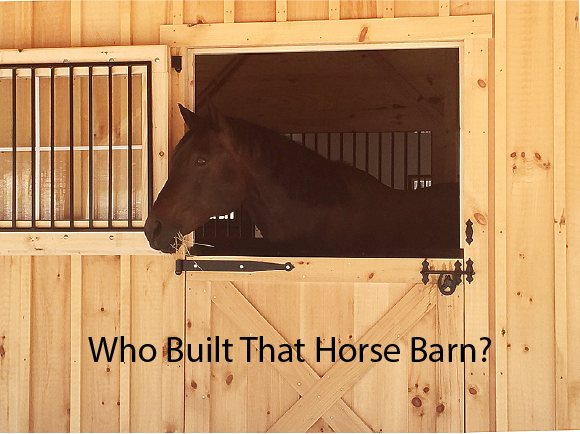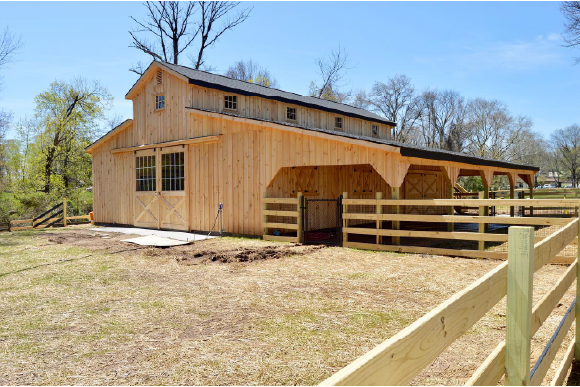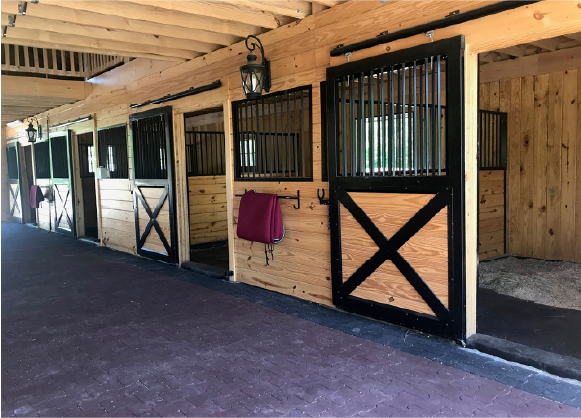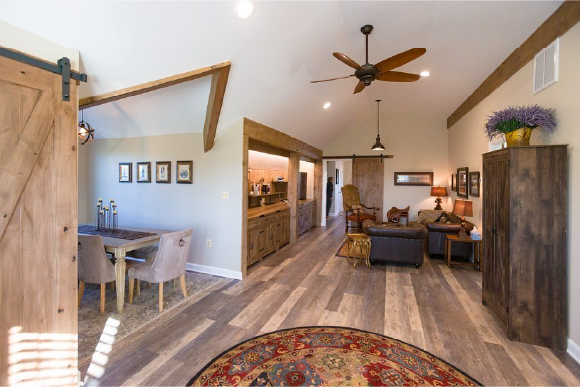Who Built That Horse Barn?
By Nikki Alvin-Smith

If you own a horse barn then this question is certain to have cropped up from visitors several times. Hopefully proud of the barn that graces the property you’ll be able to reply with confidence and recommend the builder to others and will be happy to tout the durable construction of the structure and its quality of craftsmanship. Given of course, you know who built it. But where do the best barns get built and who completes the task?
Finding the best construction company to partner up with to collaborate on a new barn build can be difficult to do – and no-one wants to discover they’ve made an error in the decision later when the barn stands in front of them. A mistake in choosing the right building partner can saddle you with a huge reminder of your blunder every time you look out the window and each time you bring a horse into a stall and the door sticks or you have to fight to close a sliding window.
Inside Look at Barns Built Inside
Factory-built barns are popular for many reasons. Not least of course the ‘to-the-penny” quote that ensures a smooth financial experience from start to finish, as well as an almost instant ‘use’ factor once the structure is delivered on site.
The advantages of factory builds are obvious in terms of pricing; quality control; and the benefit of no delays due to material supply problems, poor weather or lack of carpenters and roofers.

While expedience is important, so is the actual craftmanship of a build. If you’ve ever picked up a nail-gun or pushed a compressor about on wheels you’ll know the importance of having power supplies and tools in good working order that are handy and ready to go at a moment’s notice. Having the right tool for the job is a pre-requisite for completing a good job. And in a factory environment tools are often suspended from the ceiling on rails, easily accessed wherever they are needed, from ground level to roof top.
Consistency in materials creates a uniform look and result. In a factory-setting the materials are already selected, shipped and placed on racks ready to go. Supply stocks can be properly maintained as they are readily visible and accountable (protected from theft).
The component building materials provided that include everything from nail sizes to steel plates, wood grades, siding types, shingle or metal roofing, are not just handy they are also protected from adverse weather. Extreme temperature changes can cause wood stored outside to wrap and bend or rot/delaminate, while asphalt shingle, glue-based products and paint can also be adversely affected by the heat from hot sun or freezing temperatures.

Stain and paint applications always require specific temperature ranges in order to accomplish optimal results. An unexpected rain shower, cold spell or heatwave can really mess with the durability and appearance of the application.
As factory floors are usually concrete, the surface the framing crew work up from is level. This makes keeping measurements accurate and everything squared up easy. Marked out floor plans on some factory floors and jigs set up in different areas for specific purposes provide extra assistance when it comes to accuracy in craftsmanship. Remember every inch that something is out on the ground will magnify as you go higher.
If you’ve ever tried laying rubber mats in a stall that is inches out of square, you’ll have some idea of what a pain it is to work with on ground level. If you come to finish off your tack room with wood panels and trim with crown molding you’ll find yourself distinctly unhappy dealing with the errors made in the framing construction stage of the building where it is not a truly level, plumb and square structure.
Furthermore the concrete floor surface is solid, so there is no compression factor or mud or moisture coming up beneath the structure while it is being built.
Extended work hours to construct the barn are also possible in good light. Rather than relying on Mother Nature and working short winter hours from dawn until dusk, losing reliable light in cloudy weather or darkening skies, the construction crew have the same reliable light source all day long.
Some factories are even eco-friendly and power their own electricity needs by solar power utilizing the building’s large roof area or other modern off-the-grid technologies. It’s always good to give credit for ‘green’ business practices where they are an integral part of the company’s ethic and not purchased as credits elsewhere as an afterthought for PR or to maintain compliance to government regulations.
A happy worker will always produce a better result and do a better job than an unhappy one. Positive influences for the hardworking carpenter include working in a controlled environment in regard to temperature and without wind.
If you’ve ever stood on a roof top nailing down shingle and watched your ladder blow down or feel a stiff wind move you sideways on the ridge then you know what a bad feeling a high gust of wind can produce (I can attest to this!). Workers unaffected by variant temperatures such as freezing fingers that may cause them to rush to finish a job or hot sun that may cause them to tire and lose focus are all avoided in a factory workspace.

A controlled work environment is usually also a safer environment. Less accidents are likely to happen in a factory setting than working outside where the crew is subject to the elements, variant terrain and unfamiliar factors in the environment such as pets and livestock.
The camaraderie and knowledge of working together as a team on the building project is also better when the enterprise is conducted on a routine basis by the same crew. The assignment of specific tasks to certain people can improve efficiency but also improves their talents at the job. A local construction company owner that picks up cheap labor from the street corner every day, provides workers much less likely to be welcomed on site by the mainstay brigade and this haphazardly recruited crew aside from being illegal, is also unlikely to have the necessary experience working on the particular project at hand.
Consistent provision of a high standard of workmanship and good quality building materials is an essential component for the ultimate success of any structural build. Armed with the knowledge of what goes where, why and how, the construction crew is able to complete a final product off an assembly line set-up that arrives at site when promised and built to the high standards expected.
Lose The Stress and Mess in Barn Building
Most horse owners have many other things they’d rather be doing than supervising a construction crew. Aside from the in/out constant traffic of construction crew vehicles and large trucks making deliveries of supplies (not forgetting the noise and mud that all that can create), who wants to spend their riding time clearing the farm of flying plastic debris that has escaped from wood piles, combing the ground with a magnet searching out errant dropped nails, and listening to the radio blasting at 5.a.m. mixed with the colorful language of a construction team.
Choose an established modular company that offers a wide selection of horse barn styles and designs, clear warranties and a fair contract, financing options and a nationwide footprint such as Horizon Structures L.L.C.. They are the leader in the industry for good reason.
Yep! There are many reasons that a factory modular build horse barn is the way most people choose to go when buying a horse barn of whatever size, even the largest style that is a house and barn combined – the Barndominium. And now you know why!



